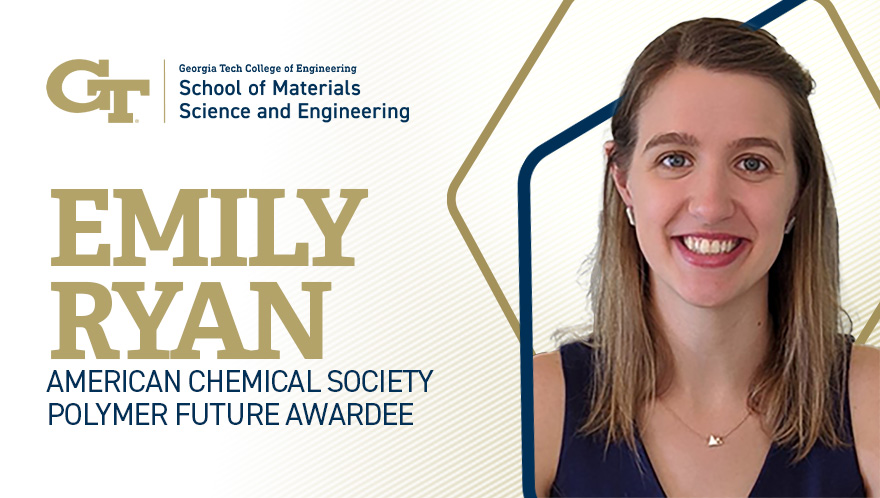
By Yvonne Medina
Emily Ryan’s postdoctoral research at Georgia Tech on an electrodynamic dust shielding polymer, with applications for removing abrasive lunar dust from space suits, earned her a polymer futures award for burgeoning leaders in polymer science from the ACS, American Chemical Society. Their polymer engineering division nominates many postdoctoral researchers and then chooses one recipient for this award. Emily’s research was chosen, and she delivered a talk at the ACS annual conference on her polymer research.
SSERVI, the Solar System Exploration Research Virtual Institute, which is funded by NASA, also funds Emily’s Ph.D. here in MSE. She researches and develops products for future space missions, solving technical problems in space by developing multi-use devices and functional materials. Most recently, this led Emily to develop innovative technologies to mitigate the abrasive qualities of lunar dust and to make space exploration both safer and more accessible with her advisers Dr. Meisha Shofner, Dr. John Reynolds, and Dr. Tom Orlando.
Before coming to Georgia Tech, Emily studied at M.I.T. and then worked at Ford Motors. She was pretty certain she would major in biology as an undergraduate at M.I.T., but she noticed that she preferred the engineering and material aspects of her bioengineering courses. She admits she was more interested in the scaffolding on which cells live and the interdisciplinary possibilities of working in bioengineering than she was in her classes with more general, less applied approaches to biology and chemistry. After graduating from M.I.T. with a B.S.E. in bioengineering in 2015, she worked for five years at the Ford Motor Company as a metallurgy engineer. At Ford, she enjoyed welding and working with polymers in aluminum, copper, and steel. All this practical work experience, she says, has been “wildly useful in polymer science-focused research.” Emily then decided to pursue a Ph.D. with the intent to return to an industry position with more expertise.
Emily was excited by the possibilities of materials science research in bridging the gap between current technology and what is needed for outer space exploration. There is a pressing need for flexible materials that can function in multiple environments, including the harshest environment humans have encountered: outer space. Apollo astronauts, for example, experienced tons of physical abrasions simply walking around the lunar environment. Lunar dust is super fine and highly chemically reactive, causing the astronauts to experience lasting respiratory issues from their interactions with lunar dust.
The polymer Emily is working on includes a dust shielding component; it is designed to lift and move the dust off the surface of a space suit. These electrodynamic dust shielding devices make the lunar environment more navigable for humans and should increase the safety of astronauts and space exploration more generally since it also protects costly materials. The implications for this polymer might also extend to helping collect scientific samples from outer space. For example, polymer scientists are working on innovating new polymers to functionalize the surface of a robotic arm, so that it is sufficiently flexible and durable in outer space conditions. Emily states that even niche projects like this one can drive scientific thought forward and have applications far beyond the targeted scope of the original project. Memory foam, camera phones, computer mice, and Dippin’ Dots, are all innovations that were originally developed for NASA.
Emily says, the “beauty of multi-departmental collaborations are the opportunities to work with people outside your area.” These interactions enrich and inspire her research. She also cites the ability to work with both undergraduates and researchers as a key strength of this department. Her advice for undergraduates majoring in biology or chemistry who are considering shifting their majors is that they should take at least one materials science class. She points out that there is a broad array of classes within material science engineering, and adds, “If you don’t like metallurgy, for example, you might really enjoy ceramics.” Here at Georgia Tech, undergraduates get hands-on experience with material science engineering methods, unlike many other similarly ranked departments. She suggests taking advantage of this rare opportunity to explore whether or not this major is right for you.